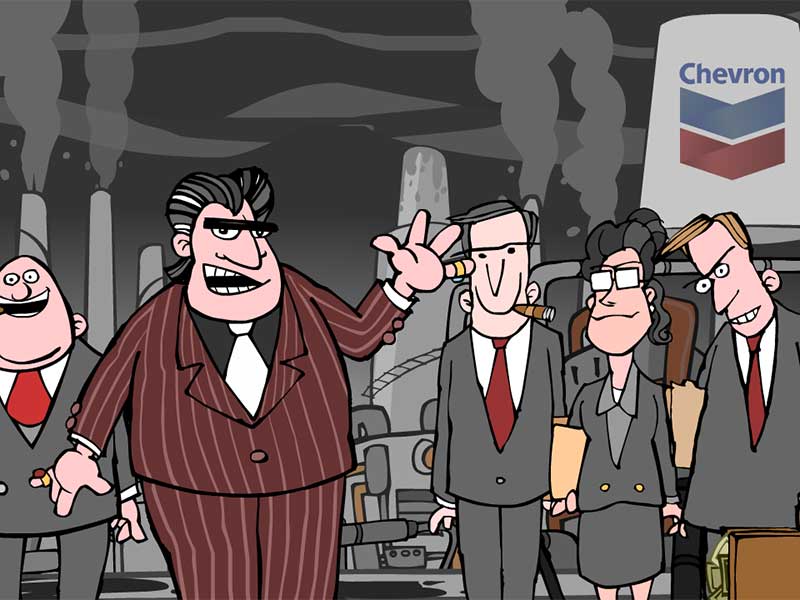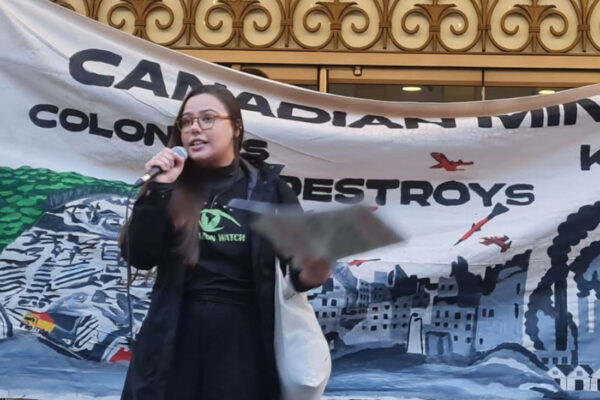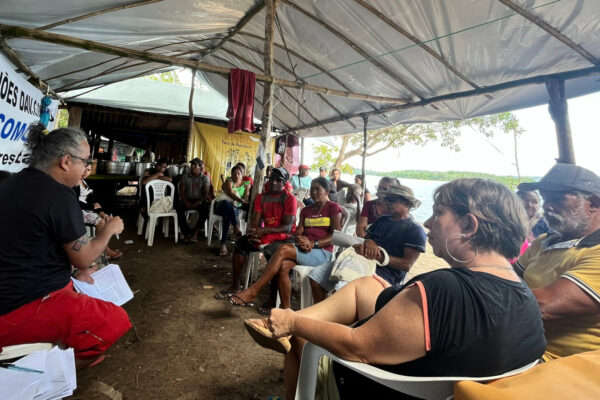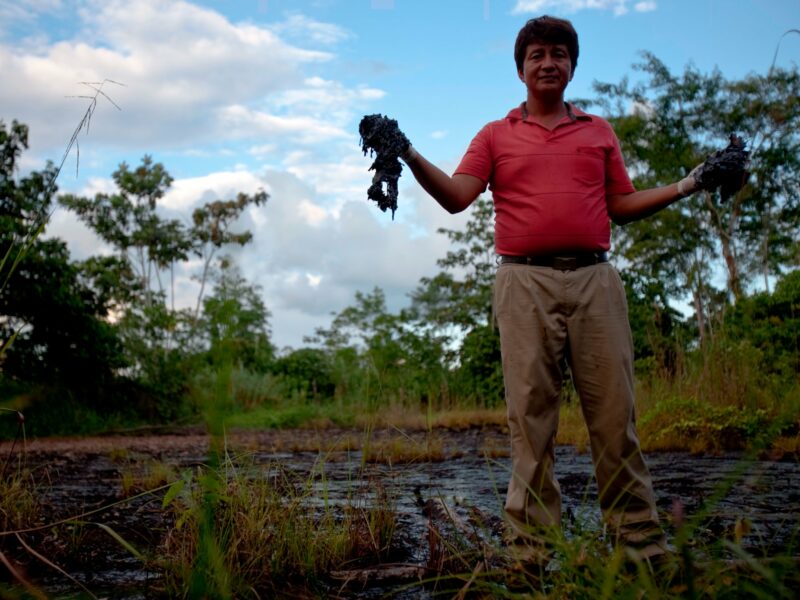Join Amazon Watch and over forty other environmental and human rights organizations denouncing Chevron’s threat to open society and freedom of speech. Amazon Watch and Pulitzer Prize winning animator Mark Fiore present The Adventures of Donny Rico. The same videos Chevron claimed to have “injured” them as reported by Salon.com. Chevron’s acts during its SLAPP suit attack against those fighting for justice for the environmental destruction and massive human suffering it left behind in Ecuador are a threat to the cause of corporate accountability. Watch Donny to learn the depths of Chevron’s attacks on free speech and why these actions are setting a new standard for silencing the critics of corporate abuses. Please share these videos and continue to speak out against Chevron’s attacks against the environmental and human rights community.
Episode One: Donny Rico & Chevron make it a crime to defend the environment
The cartoon that started it all, Donny Rico unveils Chevron’s strategy to reject Ecuador’s $9.5 billion verdict and accuse its victims of being the crooks.
To draw attention to Chevron’s threat to open society and freedom of speech Amazon Watch presents “Donny Rico”. The satirical look at Chevron’s actions highlights the serious threat to all environmental and human rights activism if the tactics Chevron has employed are replicated by other corporate actors. A grassroots campaign has already been launched by the Sierra Club and Amazon Watch asking members of the US Senate to investigate and put a stop to Chevron’s vilification of the environmental and human rights community.
Chevron’s tactics to avoid responsibility for its admitted acts of environmental destruction in the Ecuadorian Amazon have been unprecedented. Despite losing a 20-year legal battle and receiving a $9.5 billion judgment against it, Chevron says it will never pay. Not satisfied with role as corporate criminal on the run, Chevron launched an extraordinary racketeering and extortion lawsuit against the Ecuadorian and U.S. attorneys, and various consultants alleging they were all lying about Chevron’s pollution and that the entire case was “sham litigation.”
Chevron’s actions set a dangerous precedent and represent a growing and serious threat to the ability of civil society to hold corporations accountable for their misdeeds around the world. Now a wide cross-section of U.S.-based environmental and corporate governance groups have condemned Chevron’s most recent retaliatory attacks to intimidate the Ecuadorian indigenous peoples and farmers who have been harmed by the oil giant’s massive contamination of their ancestral lands.
Episode Two: Who’s Bribin’ Who?
It’s shocking to think a federal judge would allow a witness who was paid by one side for his testimony. In the real world that’s called bribery and corruption, but in Chevron and Donny Rico’s world it’s just another day at the office.
Episode 2 focuses on the absurd testimony of Chevron’s “key witness” in the bogus RICO action against the Ecuadorians and their lawyers.
The only direct testimony supporting Chevron’s key claim – i.e. that the Ecuadorian plaintiffs’ legal team “bribed” the trial judge to allow them to write the opinion – comes from Guerra, the disgraced former Ecuadorian judge who is probably one of the most openly corrupt witnesses ever to blight an American courthouse.
His entire testimony violated U.S. law, which prevents witnesses from being paid for their testimony.
Key facts about Guerra:
- He admits he accepted and paid bribes throughout his legal career, both as a practicing lawyer and as a sitting judge.
- He was removed as a judge for misconduct.
- In early 2012, he was nearly destitute and desperate to join his son and daughter living in the United States (his son illegally), but had no basis for immigration.
- At that time, a high-profile news story broke about an Ecuadorian judge accepting a decision written by a party and given to him on a flash drive. Guerra approached Chevron seeking payment with exactly the same story: he claimed he had evidence that the plaintiffs wrote the judgment and gave it to the judge on a flash drive.
- Chevron lawyer Andres Rivero and Chevron investigator Yohi Ackerman immediately paid him $18,000 in cash for his story, in violation of ethical rules against paying fact witnesses. Chevron later paid Guerra another $30,000 in cash. It then entered into an agreement to pay him $12,000 a month for at least two years and perhaps indefinitely.
- Chevron operatives then bought Guerra a car, auto insurance, and health insurance. Company lawyers then moved Guerra, his wife, and his younger son and his son’s entire family to the United States and hired lawyers to get them green cards. The incentives
for Guerra to say anything to keep the money flowing are obvious. - Guerra could never produce the flash drive. His computers did not turn up even a single email from Pablo Fajardo, the lead lawyer for the affected communities in Ecuador, despite the fact Guerra had told Chevron Fajardo had sent him a flash drive with the judgment on it. And Guerra claims to have “lost” his calendar during the year that he said he was in a meeting with Mr. Donziger where discussion of the “bribe” took place. In any event, during the time of the claimed meeting, Mr. Donziger was not even in Ecuador because of an illness in his family, according to immigration records and undisputed testimony.
- Guerra’s testimony changed constantly depending on new evidence. Other documents he produced to substantiate his account appear blatantly forged. All the while, Chevron’s high-priced attorneys from Gibson Dunn & Crutcher, led by Randy Mastro (who bills at $1,140 per hour), negotiated directly with Guerra in Chicago over his “price” while simultaneously preparing Guerra’s sworn affidavit. The entire process is a violation of the ethical rules, as this affidavit by noted legal ethicist Erwin Chemerinsky attests.
- In his decision, Judge Kaplan admitted Guerra was corrupt. Yet Judge Kaplan decided to credit Guerra’s testimony anyway. Otherwise, there would be no high-profile “bribery”
A grassroots campaign has already been launched by the Sierra Club and Amazon Watch asking members of the US Senate to investigate and put a stop to Chevron’s abuse of the justice system, and vilification of the environmental and human rights community.
Chevron’s actions in this case and elsewhere set a dangerous precedent and represent a growing and serious threat to the ability of civil society to hold corporations accountable for their misdeeds around the world. Now a wide cross-section of U.S.-based environmental and corporate governance groups have condemned Chevron’s most recent retaliatory attacks to intimidate the Ecuadorian indigenous peoples and farmers who have been harmed by the oil giant’s massive contamination of their ancestral lands.
Episode Three: Legal Tender
Chevron’s lawyers have waged an outrageous attack on the Ecuadorians and their allies. Paying some witnesses and intimidating others Gibson Dunn has built a reputation as the firm that does whatever it takes to win – Donny Rico style.
Episode 3 focuses on the unethical and underhanded tactics of Chevron’s key law firm Gibson Dunn & Crutcher in their RICO suit against the own victims in Ecuador.
Chevron hired a law firm willing to throw ethics to the wind and take extraordinary steps to concoct a story of Chevron as the actual VICTIM of a conspiracy. Just imagine what it would take to try to turn the tables after Chevron had ADMITTED to dumping toxic waste into the Amazon rainforest.
This is the same firm the Montana Supreme Court blasted for using “legal thuggery” and “blatant and malicious intimidation” tactics while another U.S. federal judge said the firm maintained “a culture [of] obstruction and gamesmanship.”
Gibson Dunn is quite open about using a template to defend its high-profile corporate clients who are losing legal cases or are trapped in scandal. It does this by targeting the lawyers or witnesses who held their clients accountable with character assassination and defamation campaigns.
Gibson Dunn masterminded a strategy where a single U.S. judge with more arrogance than Dick Cheney re-litigated the eight-year Ecuador trial in his courtroom in what can only be described as a Kafkaesque proceeding. The judge refused to consider the Ecuador trial record, the 64,000 chemical samplings results that proved Chevron committed a massive environmental crime, or the Supreme Court decision that already considered Chevron’s complaints and rejected them.
How did Chevron and Gibson Dunn get it done? First they spent years trying to create dirt and get it to stick. They mounted racist attacks on Ecuador, hired PR firms and bloggers to attack the Ecuadorian communities, Ecuador’s legal system, and of course the lawyers, activists, human rights defenders or allies supporting them. They launched “sting” operations, attempted to entrap judges, hid information about contamination from the court and turned a straightforward case into what is probably the most abusively litigated nightmare in the history of world jurisprudence.
Chevron and Gibson Dunn filed dozens of discovery lawsuits across the US and racked up over $36 million in legal fees. They tried to find any court that would hear their trumped up allegations. Many rejected them and one federal appellate court in Philadelphia reversed a discovery order stating “[t]he circumstances supporting [Chevron’s] claim of fraud largely are allegations and allegations are not factual findings.” The appeals court further chastised Chevron’s attacks on the Ecuador courts as “disparaging”. Some judges dismissed the firm’s legal attacks under laws designed to fight “SLAPPs” – Strategic Lawsuits Against Public Participation, i.e. intimidation suits – while others ordered Gibson Dunn to pay fees to its adversary and other sanctions.
One could write hundred of pages detailing Gibson Dunn’s dirty tactics. As Donny mentions, Gibson Dunn’s lead lawyer Randy Mastro personally met in Chicago with Chevron’s key witness – disgraced ex-judge Guerra – to negotiate the exchange of huge sums of money and other benefits in exchange for his “factual” testimony. They also doctored video evidence and possibly engaged in fraud on the Ecuador court by failing to disclose that its technicians were ordered to hide dirty soil samples.
Episode Four: T’anks Judge!
Judge Lewis Kaplan conducted an outrageous trial in New York, which barred evidence of contamination, allowed secret witnesses, and forbade a jury. His bias was palpable, which makes sense considering it was his idea for Chevron to file the case, and he assigned it to himself.
Donny Rico continues his series with Episode 4, “T’anks Judge” demonstrating another part of Chevron’s efforts to get away with its massive pollution in the Amazon. Recognizing it was going to lose, and lose big in Ecuador, Chevron began searching desperately for other courts that might find in its favor (despite arguing Ecuador was the best venue for years). The company hit pay-dirt when it found Judge Lewis Kaplan, a U.S. Federal Judge. Kaplan himself suggested the RICO case, and then assigned it to his own courtroom. There’s only one problem, Kaplan’s decision in favor of Chevron is deeply flawed both legally and factually and resulted from a bench trial overseen by a judge who repeatedly demonstrated his animus toward the Ecuadorian villagers and their counsel.
Judge Kaplan’s decision has no credibility – it is void for lack of jurisdiction and ruthlessly distorts the truth. In an unprecedented display of judicial overreach, Judge Kaplan tried to use his Manhattan courtroom to reverse a unanimous decision from Ecuador’s Supreme Court involving questions of Ecuadorian law. Judge Kaplan’s decision is also in open defiance of a prior decision in the very same case from the Second Circuit Court of Appeals, which barred him from ruling as he did on the validity of a foreign country’s judgment.
During the seven-week RICO trial, Judge Kaplan made a mockery of the rule of law. He refused to seat a jury and then let Chevron’s army of lawyers use the jury room as a private office. He then repeatedly denied the defendants the opportunity to present the voluminous and unassailable scientific evidence that proves the Ecuador judgment is valid. He also refused evidence that Chevron repeatedly attempted to corrupt and sabotage the proceedings in Ecuador because it knew it was losing on the merits. Tellingly, Judge Kaplan refused to even read the official record from the Ecuador trial that was relied on by the Ecuadorian courts to find Chevron liable.
Kaplan’s decision is under appeal and is expected by many to be overturned.
Episode Five: Be the Victim
Donny Rico and Chevron’s strategy to turn the tables on communities and activists fighting for justice involves casting themselves as the victims. Donny explains how they did it and why other corporations may soon be using the same tactics.
Chevron has been able to change the discussion from shock and outrage at its massive oil contamination to a “legal drama” where it claims to be the victim. While Ecuadorian communities continue to get sick and die from Chevron’s deliberate toxic contamination the story of this tragedy has now turned to Chevrons bogus claims. Only a multi-billion dollar effort could achieve such a perverted result. Rather than asking how it is that Chevron could allow people to continue to die from its toxic waste, many are actually casting Chevron as the victim. In a case about fraud completely fabricated from edited video outtakes, falsified evidence and testimony by paid witnesses; Chevron has stopped even responding about its environmental crimes. When videos were released by a Chevron whistleblower proving the company knew the toxic pits it swore to have fully cleaned still contaminated Amazon waterways, Chevron was not forced to explain itself. Instead, it pushed a lie of extortion and blamed the very people it interviewed on film as fraudsters.
Turning this tragic story of deliberate pollution and loss of human life into a drama about lawyers is frankly disgusting. And that was ultimately the objective of Chevron and its team of lawyers and PR firms – they wanted a verdict from a judge they could influence who would strike all evidence of their actual crime and allow them to present thousand of pages of distorted “evidence” to overwhelm the court and the defense. Indeed, massive fraud happened – Chevron switched soil samples to hide toxic evidence, hired ex-convicts and drug smugglers to try to entrap judges, bribed witnesses and intimidated others and abused the justice system in Ecuador and the United States to create a talking point and sell a story to the world that Chevron is the victim.
This final Donny Rico video is a warning to everyone that Chevron’s tactics are going to be copied by others. Our democracy and our movement for better corporate accountability are in grave danger. We hope you will watch share and then act to prevent Chevron from getting away with this despicable attack on free speech and our system of justice.














